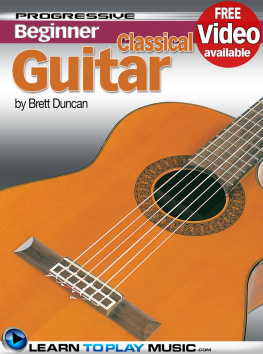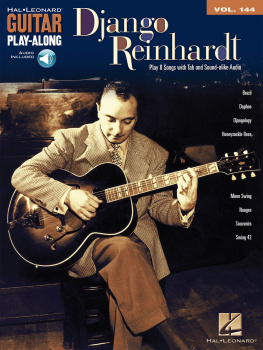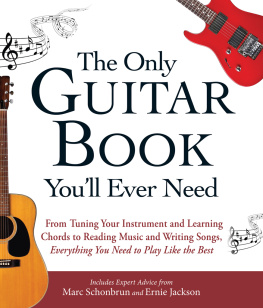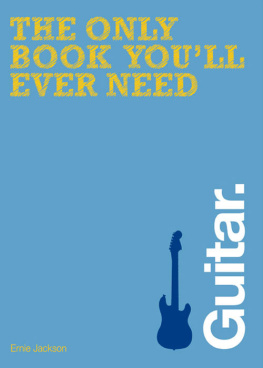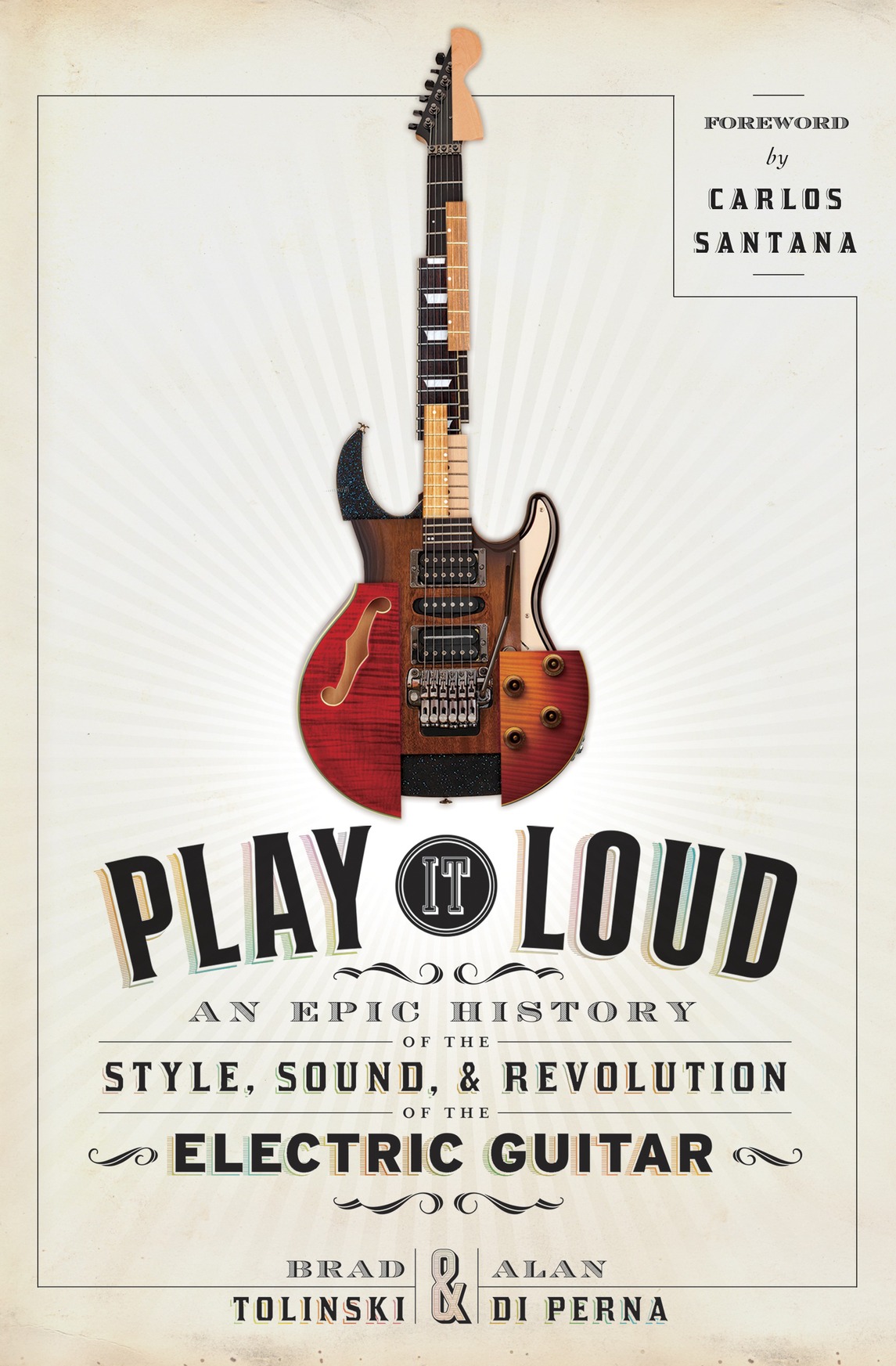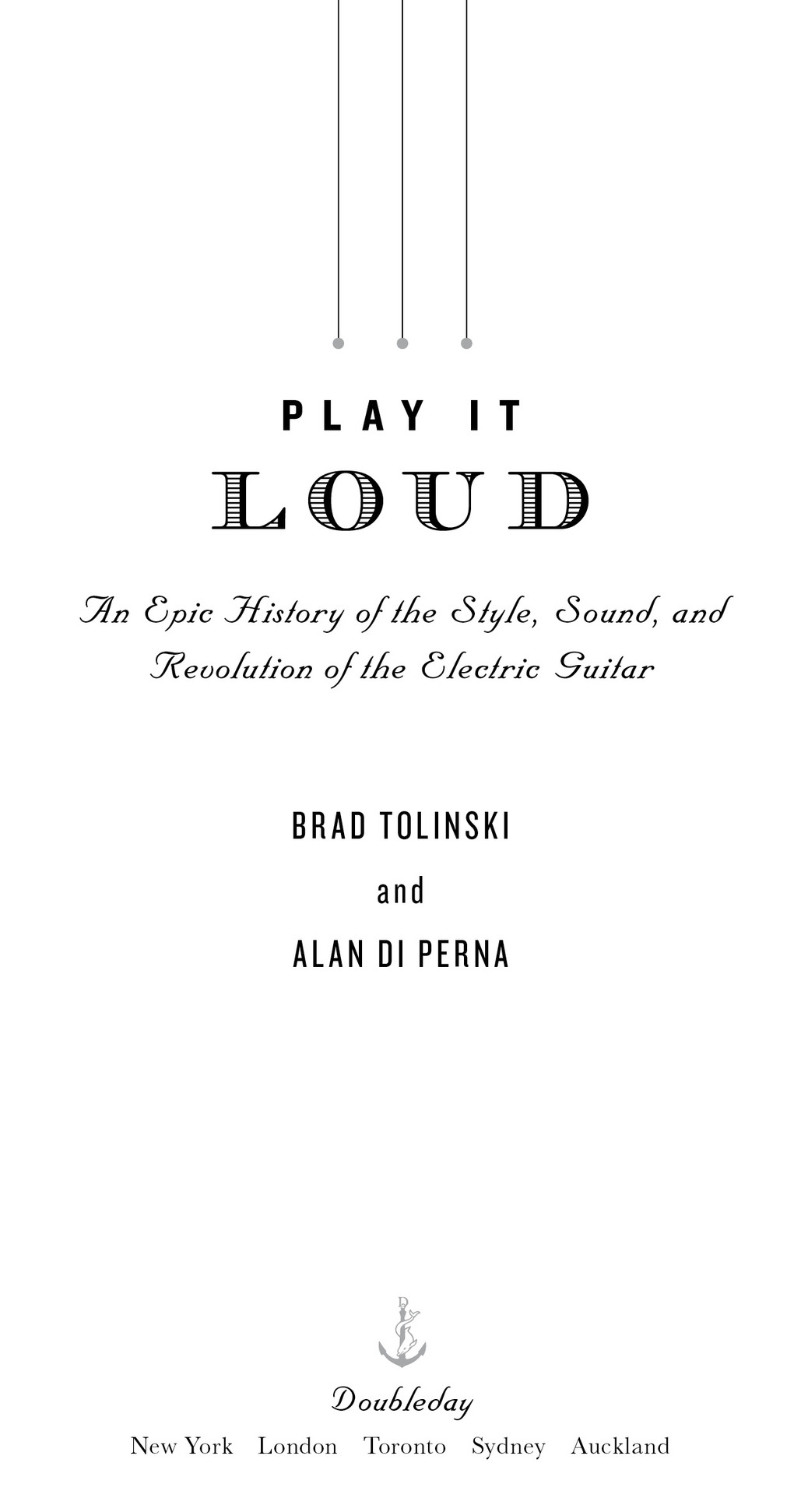ALSO BY BRAD TOLINSKI
Light & Shade: Conversations with Jimmy Page
Classic Hendrix: The Ultimate Hendrix Experience
ALSO BY ALAN DI PERNA
Guitar Masters: Intimate Portraits
Green Day: The Ultimate Unauthorized History
Copyright 2016 by Brad Tolinski and Alan di Perna
Foreword copyright 2016 by Carlos Santana
All rights reserved. Published in the United States by Doubleday, a division of Penguin Random House LLC, New York.
www.doubleday.com
DOUBLEDAY and the portrayal of an anchor with a dolphin are registered trademarks of Penguin Random House LLC.
Cover composite image: Various electric guitars. Shutterstock
Cover design by Michael J. Windsor
Library of Congress Cataloging-in-Publication Data
Names: Tolinski, Brad, author. Di Perna, Alan, [date], author.
Title: Play it loud : an epic history of the style, sound, and revolution of
the electric guitar / Brad Tolinski and Alan di Perna.
Description: First edition. New York, NY : Doubleday, 2016.
Includes bibliographical references and index.
Identifiers: LCCN 2016013874 ISBN 9780385540995 (hardcover)
ISBN 9780385541008 (ebook)
Subjects: LCSH: Electric guitarHistory.
Classification: LCC ML1015.G9 T66 2016 DDC 787.8709dc23 LC record available at http://lccn.loc.gov/2016013874
Ebook ISBN9780385541008
v4.1
ep
Contents
For Robin Lee Zarin di Pernaan angel sent to me
ALAN DI PERNA
For Izzy Zay, my rock n roll queen
BRAD TOLINSKI
FOREWORD
Play It Loud is a dynamic history of the electric guitar, but more important, its about the artists who painted the universal tones, colors, textures, and movements on the world canvas, through their fingertips, into a consciousness revolution to our hearts and minds. Brad and Alan get inside the note of the political and cultural significance of the guitar.
To me, the guitar symbolizes rebellion, liberation, and freedom of expression. It is a doorway through which we can profoundly touch peoples hearts and souls and change lives. In the 60s we had the Black Panthers, Woodstock, and Vietnam, and the electric guitar became the iconic voice of our generationfrom Dylan and the Beatles to Hendrix at Woodstock. Throughout the 70s we continued to question and shape the world around us through melody, rhythm, message, and song. The guitar helped open up the world. It broke down the racial barriers against black musicians who were our pioneers long before the British Invasion. Those musicians invaded us with music that was born here in the United States. B. B. King, Howlin Wolf, Muddy Waters, Jimmy Reed, Buddy Guy, John Lee Hooker, and all the other greats survived because of their love for music. The guitar created a voice for the voiceless, bringing their lives to ours.
To be able to touch someone and change their molecular structure with just one note is very powerful. One note can bring someone back from the edge, make lovers come together, create life, end wars, and make you shed tears of joy and sorrow at the same time. It is called the universal tone, and for me it comes from six things I strive for every time I plug in my guitar: stay genuine, honest, sincere, true, authentic, and for real on every song. Play It Loud is all of these things, on every page.
CARLOS SANTANA
PREFACE
Born in Roaring Twenties Southern California to a band of creative outsiderstransplants from the Dust Bowl, the Midwest, and Europethe electric guitar very quickly grew into one of the defining symbols of our time. There are few greater, more prevalent modern icons. When used in advertising (as it often is), it is shorthand for freedom, danger, and unabashed hedonism. In the hands of a musician, it signifies artistry and rebellion. Its inventors ambitions may have been modest, but the instrument they conceivedvisually striking in appearance, utterly practical in its applicationwould leave an indelible imprint on our history.
Long before anyone thought to amplify it, the guitar proved a remarkably versatile musical instrument. Its six strings and wide four-octave range could be used for chordal accompaniment or melodic single-note soloing, in almost any style. Its biggest asset, however, was its remarkable portability. Unlike a piano, a guitar could be slung over your shoulder and played just about anywhere. The instrument was also democratic. Affordable models were available and relatively easy to play. (As Rolling Stones legend Keith Richards once said, half in jest, Guitar is easy. All it takes is five fingers, six strings, and one asshole.)
But electrified and amplified, the guitar became positively protean, infinitely malleable and amenable to each players creative vision. In the hands of blues guitarist B.B. King, the instrument became an expressive solo voice that could sing, cry, and moan like a man in the pit of despair, or a woman in the throes of ecstasy. For the Beatles, it became a jangling orchestra that provided color, harmony, and heft to their timeless pop songs. Funk rhythm guitarist Jimmy Nolen used his axe almost like an amplified washboard, playing a Morse code of chicken scratches to power countless James Brown hits, such as Papas Got a Brand New Bag.
As players and instrument developed across the decades, a staggering sonic repertoire emerged. The resources of feedback and distortion allowed an electric guitar to evoke a nuclear meltdown, a dive-bombing aircraft, the ominous thrum of heavy machinery. But it is just as capable of producing crystalline tones and shimmering texturesthe soundscapes of our most vivid dreams. This unprecedented range would allow the electric guitar to play a key role in a dazzling spectrum of musical idioms, from the hot jazz and Hawaiian music that formed the soundtrack of its creation to modern-day alternative rock, hard rock, heavy metal, contemporary country, and postmodern art music.
But the electric guitar would represent much more than just musical innovation. It would directly and indirectly impact the entertainment industry, politics, art, the economy, and many other facets of our cultural life. The instruments burgeoning popularity played a small but nonetheless significant role in advancing the cause of racial integration. It became a symbol of the counterculture sixties, rallying opposition to the Vietnam War, as its urgent clangor pushed forward the sexual revolution and progress toward gender equality. The curvy contours and electronic appointments of the electric guitar were of a piece with the mid-century modernist movement in industrial, automotive, architectural, domestic, and fashion design, which was finding a voice just as electric guitar builders were hitting their stride. And its sound would become deeply embedded in the popular culture of the modern and postmodern eras. Its lineaments are a map of our progress through the twentieth century and into the digitized world of today.
The electric guitars enshrinement in our cultural pantheon was cemented in 1977, when NASA launched two spacecraft whose missions were to explore the outer limits of our solar system and beyond. Voyager 1 became the first human-made object to venture into interstellar space, and is currently about twelve billion miles from our sun, with






